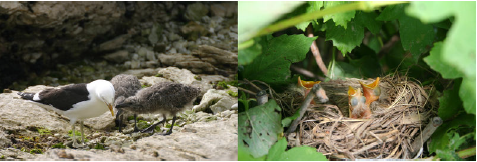Reading: Innate Behavior of Animals
http://www.ck12.org/saythanks
• Explain and give examples of innate behavior.
How do kittens know how to "hunt"?
This kitten was probably adopted and separated from its mother at a young age. It never got a lesson in how to stalk and pounce on prey. So how does this kitten know how to attack the ball of yarn? Some behaviors do not need to be learned.
Innate Behavior
Many animal behaviors are ways that animals act, naturally. They don’t have to learn how to behave in these ways. Cats are natural-born hunters. They don’t need to learn how to hunt. Spiders spin their complex webs without learning how to do it from other spiders. Birds and wasps know how to build nests without being taught. These behaviors are called innate.
An innate behavior is any behavior that occurs naturally in all animals of a given species. An innate behavior is also called an instinct. The first time an animal performs an innate behavior, the animal does it well. The animal does not have to practice the behavior in order to get it right or become better at it. Innate behaviors are also predictable. All members of a species perform an innate behavior in the same way. From the examples described above, you can probably tell that innate behaviors usually involve important actions, like eating and caring for the young.
There are many other examples of innate behaviors. For example, did you know that honeybees dance? The honeybee pictured below has found a source of food ( Figure 1.1). When the bee returns to its hive, it will do a dance. This dance is called the waggle dance. The way the bee moves during its dance tells other bees in the hive where to find the food. Honeybees can do the waggle dance without learning it from other bees, so it is an innate behavior.
Besides building nests, birds have other innate behaviors. One example occurs in gulls, which are pictured below (Figure 1.2); one of the chicks is pecking at a red spot on the mother’s beak. This innate behavior causes the mother to feed the chick. In many other species of birds, the chicks open their mouths wide whenever the mother returns to the nest ( Figure 1.2). This innate behavior, called gaping, causes the mother to feed them.

FIGURE 1.1
When this honeybee goes back to its hive, it will do a dance to tell the other bees in the hive where it found food.

FIGURE 1.2
Left: This mother gull will feed her chick after it pecks at a red spot on her beak. Both pecking and feeding behaviors are innate. Right: When these baby birds open their mouths wide, their mother instinctively feeds them. This innate behavior is called gaping.
Another example of innate behavior in birds is egg rolling. It happens in some species of water birds, like the graylag goose ( Figure 1.3). Graylag geese make nests on the ground. If an egg rolls out of the nest, a mother goose uses her bill to push it back into the nest. Returning the egg to the nest helps ensure that the egg will hatch.

FIGURE 1.3
This female graylag goose is a groundnesting water bird. Before her chicks hatch, the mother protects the eggs. She will use her bill to push eggs back into the nest if they roll out. This is an example of an innate behavior. How could this behavior increase the goose’s fitness?
Innate Behavior in Human Beings
All animals have innate behaviors, even human beings. Can you think of human behaviors that do not have to be learned? Chances are, you will have a hard time thinking of any. The only truly innate behaviors in humans are called reflex behaviors. They occur mainly in babies. Like innate behaviors in other animals, reflex behaviors in human babies may help them survive.
An example of a reflex behavior in babies is the sucking reflex. Newborns instinctively suck on a nipple that is placed in their mouth. It is easy to see how this behavior evolved. It increases the chances of a baby feeding and surviving. Another example of a reflex behavior in babies is the grasp reflex ( Figure 1.4). Babies instinctively grasp an object placed in the palm of their hand. Their grip may be surprisingly strong. How do you think this behavior might increase a baby’s chances of surviving?
FIGURE 1.4
One of the few innate behaviors in human beings is the grasp reflex. It occurs only in babies.
Vocabulary
• gaping: Wide opening of a baby bird’s mouth in expectation of feeding.
• innate behavior: Any behavior that occurs naturally in all animals of a given species.
• instinct: Ability of an animal to perform a behavior the first time it is exposed to the proper stimulus.
• reflex behaviors: Any behavior that occurs without conscious thought as a response to a stimulus.
• waggle dance: Way a honeybee moves to tell other bees in the hive where to find the food.
Summary
• Innate behavior, or instinct, is any behavior that occurs naturally in all animals of a given species.
• Examples of innate behavior include honeybees doing the waggle dance or spiders spinning a web.
Review
1. What is an innate behavior?
2. What are two examples of reflex behaviors in humans?
3. What are two examples of innate behavior in animals?
4. Is an instinct an innate behavior? Explain your answer.
